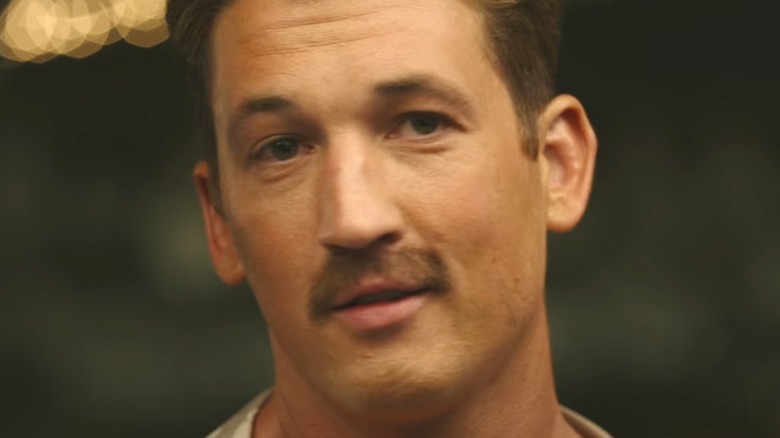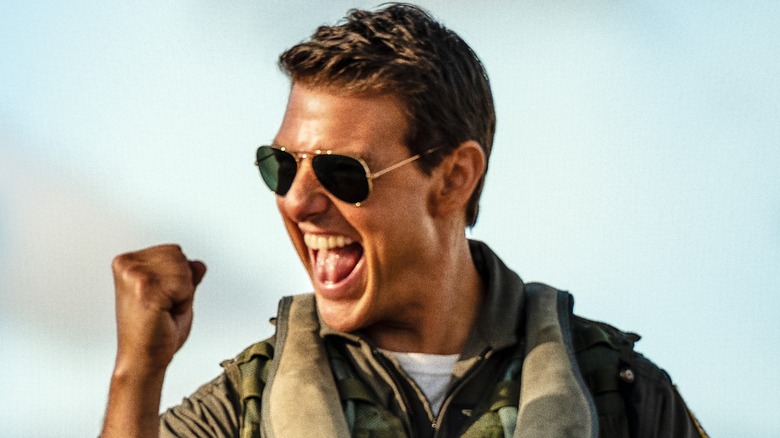All The Rules Top Gun: Maverick Had To Follow To Gain U.S. Navy Approval And Rent Its Jets
It shouldn't come as a big surprise that the producers of "Top Gun: Maverick" needed to film the new action-adventure thriller with the help of the U.S. Navy. After all, the cost of building their own fighter jets and an aircraft carrier for a film would be astronomical, so to ensure the film's authenticity, star-slash-producer Tom Cruise and his colleagues had only one alternative: They sought the cooperation of the military for the sequel to the 1986 classic "Top Gun" and found out that the partnership came with a strict set of rules.
Chief among the stipulations was what Cruise and company could do with the spendy F/A-18E/F Super Hornets highlighted in the film. The Navy certainly has a good reason to be concerned with how their equipment is handled. According to Forbes, the government contracted Boeing in 2019 to build 78 Super Hornets for a staggering cost of $4 billion, which equates to more than $51 million per fighter jet.
In playing with such expensive toys, even Cruise was told that he had to be careful with what he could and couldn't do to feel the need for speed once again in "Top Gun: Maverick."
Top (Gun) stipulation: Cruise couldn't touch the controls of the fighter jets
In "Top Gun: Maverick," Cruise reprises his role as Pete "Maverick" Mitchell, who, decades after the events of "Top Gun," is called upon by his rival turned best friend Admiral Tom "Iceman" Kazansky (Val Kilmer) to head up a dangerous mission to destroy a uranium enrichment plant in a country that hasn't been sanctioned to do it. Returning to the Top Gun program, Maverick is tasked with training 12 elite graduates who are all skilled in flying the technologically advanced aircraft, including the embittered Lt. Bradley "Rooster" Bradshaw (Miles Teller) — the son of Mav's late co-pilot, Goose (Anthony Edwards).
Renting real fighter jets didn't come cheap to the production. According to Fortune, the Navy rented the F/A-18E/F Super Hornets to the producers of "Top Gun: Maverick" for $11,374 an hour. That didn't mean the production could do what they wished with the jets. Among the top stipulations, Fortune said, were that Cruise — who has long insisted on doing his own stunts in a practical manner — could not touch any of the controls on the jets he flew in.
As such, Cruise and his co-stars were required to film all of their flight scenes in the seat behind the F/A-18E/F fighter pilot — and that could only happen if they finished rigorous training requirements beforehand. The rental and training requirements, however, weren't the only rules the production had to follow.
Top Gun: Maverick had to 'uphold the integrity of the military'
Following in the footsteps of Maverick and Iceman in "Top Gun," most of the young pilots in "Top Gun: Maverick" are brimming with confidence if not outright arrogant. As it turns out, that's one of the few concessions the military makes when it allows Hollywood to portray the service on the big screen. In reality, the chief of the Pentagon's entertainment media office, Glen Roberts, told Fortune, the sorts of pilots you see in the new "Top Gun" movie "would never exist in naval aviation."
And while Roberts noted to Fortune that a filmmaking production "does not have to be a love letter to the military," it does "need to uphold the integrity of the military." As a result, filmmakers need to submit their scripts to the military for review, although Roberts said that he wasn't aware of the Navy requesting any changes for the new "Top Gun" chapter.
Also starring Jennifer Connelly, Bashir Salahuddin, and Jon Hamm, "Top Gun: Maverick" is playing exclusively in theaters.


